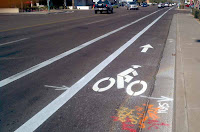
(motorist) Cal Holman was killed in a horrific traffic collision in 2007 involving very high speeds and alleged street racing. Going on 5 years later a lot has and continues to happen, the two other drivers, Van Brakel and Aronica, have eventually plead guilty to certain crimes, Van Brakel going to prison for manslaughter. Aronica received probation, and subsequently requested it be reduced, but that apparently was denied.
The site friendsofcalholman.com is doing, and has done an excellent job of making court documents available; such as the plea agreements. Van Brakel’s 5 year sentence was reduced to below 3 years actual both by the 1 day for every 7 served (that’s normal; it where the “85%” figure comes from); but also apparently because of “over 2 years credit because he was out on bail while the criminal hearings were going on“. How does that work? Being out on bail somehow counts as the same as being incarcerated? [see suggestion in comment below that this may have been erroneously calculated] This is criminal case CR2008-031157 (minutes) (which i could only find by searching Maricopa County Superior directly) — and here is Van Brakel’s (who is Party 001) 9/16/2011 sentencing minute “5 year(s) from 09/16/2011; Presentence Incarceration Credit: 487 day(s); Presumptive”. Note that this is “non-dangerous” manslaughter — sick joke. p.s. the way sentencing math works apparently is: 85% (assuming he got the most time off) of 5 years is 1551 days minus the 487 leaves 1064 (just under 3 years).
Van Brakel’s pre-sentence credit of 487 days was due to him being incarcerated immediately (i guess) after his initial sentencing in 2010.
Here is Aronica’s 5/18/2010 sentencing minute of probation; pleading guilty to two counts of endangerment which is, like Van Brakel’s manslaughter, designated as a “non-dangerous” crime.
On a larger scope, they have exposed these two men’s driving history; again something we rarely get to see. According to friendsofcalholman the two,
Van Brakel was driving an AMG Mercedes, after hitting Cal Holman his car continued 75 feet past the intersection. Van Brakel hit first on the passenger side. He did not sustain any injuries in the crash… Since 2004 there have been 7 tickets for various moving violations. Driving 55 in a 35 zone, 67 in a 40 zone, and failing to yield in a cross walk are a sample of his driving record… Van Brakel has several previous driving violations. One ticket in 2004, was for doing 120 miles per hour in a 75 miles per hour zone. [link]
and the other:
Aronica’s Mustang flipped on impact and landed in the ditch on the side of Scottsdale … Aronica was injured with a broken arm and his passenger had minor cuts…. Since 2002 Aronica has had 13 citations. On December 3rd, less than four weeks prior to the accident where he hit and killed Cal Holman, he was cited for doing 88 miles per hour in a 60 miles per hour zone. This was in Texas while he was traveling to Arizona… Other citations include speeding. In Virginia speeding 84 in a 65 zone, in Florida traveling 20-29 miles per hour over the posted speed, again in Virginia speeding 79 in a 65 zone, in Maryland he had four speeding violations, and in Michigan he has 3 violations for speeding including a careless driving and a 78 in a 55 zone. [link]
This really makes me wonder how such repeated dangerous driving behavior can be tolerated — why weren’t their licenses suspended or revoked before they killed somebody? Traffic collisions, even after a marked decline, continue to be a leading cause of death for Americans. Who’s minding the store?




